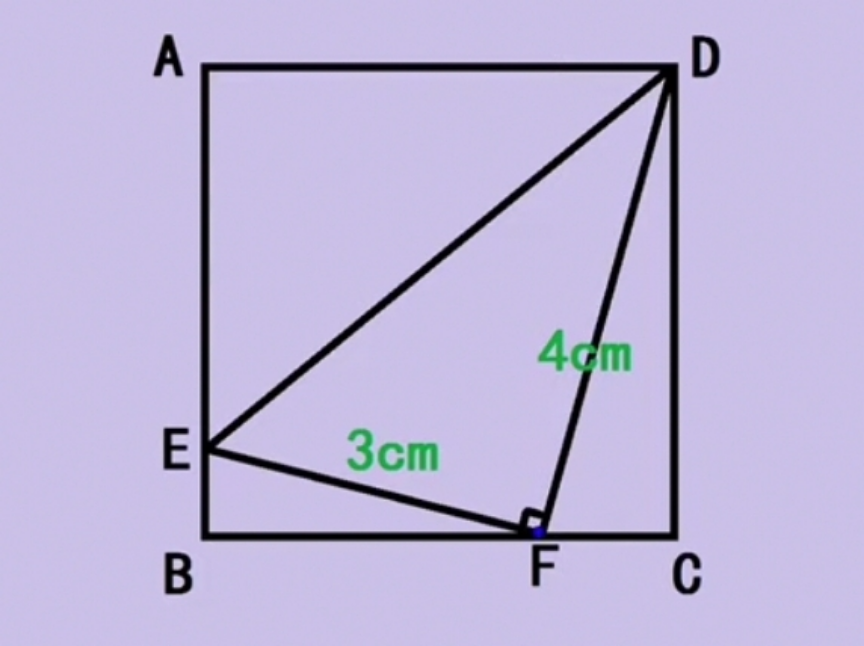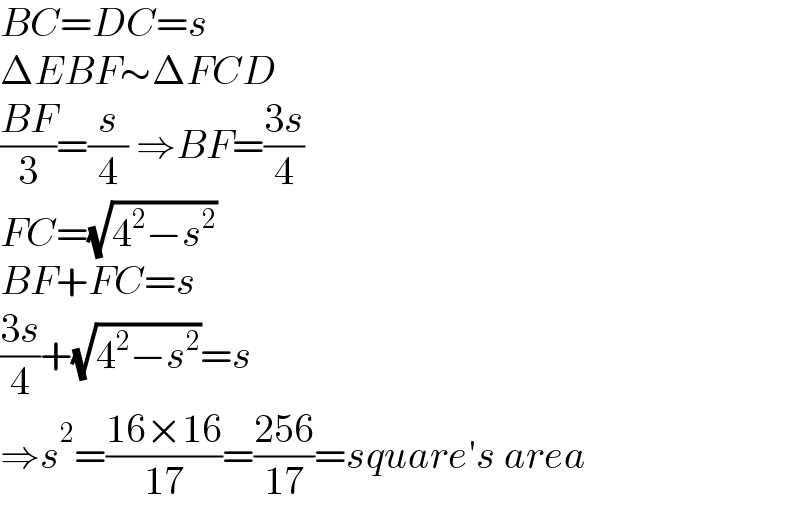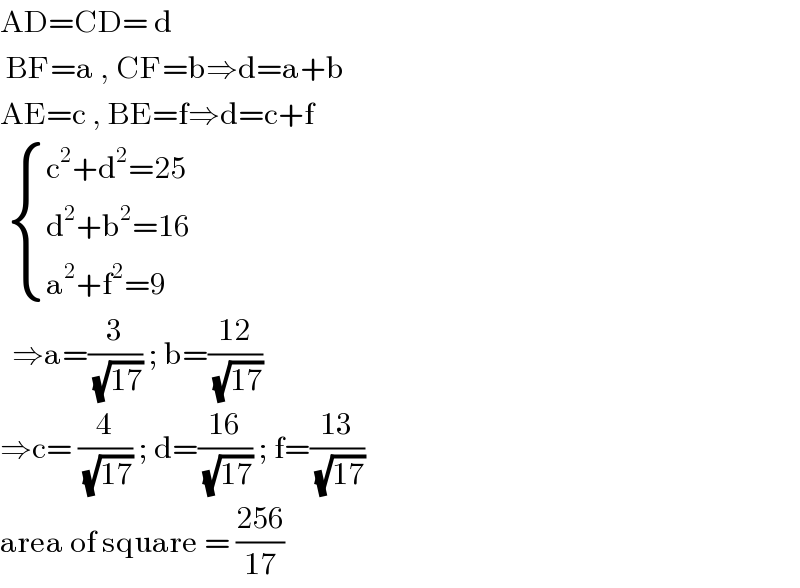Question Number 177796 by mr W last updated on 09/Oct/22

Commented by mr W last updated on 09/Oct/22

$${find}\:{the}\:{area}\:{of}\:{the}\:{square}. \\ $$
Commented by mr W last updated on 09/Oct/22

$$\angle{DFE}=\mathrm{90}° \\ $$$${side}\:{length}\:{of}\:{square}\:{should}\:{be}\:{unique}. \\ $$
Commented by Rasheed.Sindhi last updated on 09/Oct/22

$${You}'{re}\:{right}\:\boldsymbol{{sir}}! \\ $$
Commented by Rasheed.Sindhi last updated on 09/Oct/22

$$\boldsymbol{{Sir}}\:{I}\:{think}\:{that}\:{the}\:{area}\:{depends}\: \\ $$$${upon}\:{BE}\:{or}\:{FC}.\:{In}\:{other}\:{words} \\ $$$${the}\:{area}\:{of}\:{square}\:{is}\:{not}\:{unique}. \\ $$
Answered by mr W last updated on 09/Oct/22

$${BC}={DC}={s} \\ $$$$\Delta{EBF}\sim\Delta{FCD} \\ $$$$\frac{{BF}}{\mathrm{3}}=\frac{{s}}{\mathrm{4}}\:\Rightarrow{BF}=\frac{\mathrm{3}{s}}{\mathrm{4}} \\ $$$${FC}=\sqrt{\mathrm{4}^{\mathrm{2}} −{s}^{\mathrm{2}} } \\ $$$${BF}+{FC}={s} \\ $$$$\frac{\mathrm{3}{s}}{\mathrm{4}}+\sqrt{\mathrm{4}^{\mathrm{2}} −{s}^{\mathrm{2}} }={s} \\ $$$$\Rightarrow{s}^{\mathrm{2}} =\frac{\mathrm{16}×\mathrm{16}}{\mathrm{17}}=\frac{\mathrm{256}}{\mathrm{17}}={square}'{s}\:{area} \\ $$
Commented by Tawa11 last updated on 09/Oct/22

$$\mathrm{Great}\:\mathrm{sirs} \\ $$
Answered by cortano1 last updated on 09/Oct/22

$$\mathrm{AD}=\mathrm{CD}=\:\mathrm{d} \\ $$$$\:\mathrm{BF}=\mathrm{a}\:,\:\mathrm{CF}=\mathrm{b}\Rightarrow\mathrm{d}=\mathrm{a}+\mathrm{b} \\ $$$$\mathrm{AE}=\mathrm{c}\:,\:\mathrm{BE}=\mathrm{f}\Rightarrow\mathrm{d}=\mathrm{c}+\mathrm{f} \\ $$$$\:\begin{cases}{\mathrm{c}^{\mathrm{2}} +\mathrm{d}^{\mathrm{2}} =\mathrm{25}}\\{\mathrm{d}^{\mathrm{2}} +\mathrm{b}^{\mathrm{2}} =\mathrm{16}}\\{\mathrm{a}^{\mathrm{2}} +\mathrm{f}^{\mathrm{2}} =\mathrm{9}}\end{cases} \\ $$$$\:\:\Rightarrow\mathrm{a}=\frac{\mathrm{3}}{\:\sqrt{\mathrm{17}}}\:;\:\mathrm{b}=\frac{\mathrm{12}}{\:\sqrt{\mathrm{17}}} \\ $$$$\Rightarrow\mathrm{c}=\:\frac{\mathrm{4}}{\:\sqrt{\mathrm{17}}}\:;\:\mathrm{d}=\frac{\mathrm{16}}{\:\sqrt{\mathrm{17}}}\:;\:\mathrm{f}=\frac{\mathrm{13}}{\:\sqrt{\mathrm{17}}} \\ $$$$\mathrm{area}\:\mathrm{of}\:\mathrm{square}\:=\:\frac{\mathrm{256}}{\mathrm{17}} \\ $$
Answered by cortano1 last updated on 09/Oct/22

$$\frac{\mathrm{256}}{\mathrm{17}}\:? \\ $$
Commented by mr W last updated on 09/Oct/22

$${yes}! \\ $$
